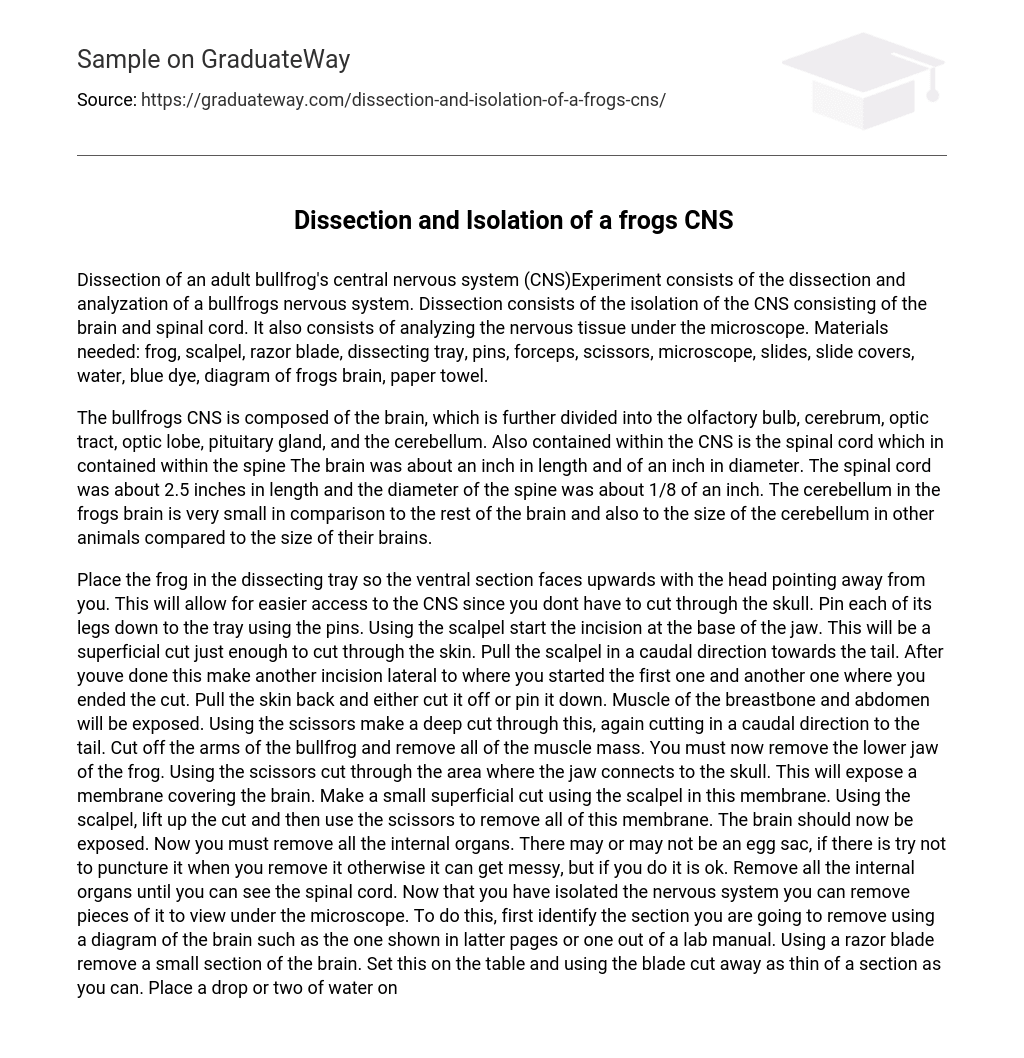The experiment consists of the dissection and analyzation of a bullfrogs nervous system. Dissection consists of the isolation of the CNS consisting of the brain and spinal cord. It also consists of analyzing the nervous tissue under the microscope. Materials needed: frog, scalpel, razor blade, dissecting tray, pins, forceps, scissors, microscope, slides, slide covers, water, blue dye, diagram of frogs brain, paper towel. The bullfrogs CNS is composed of the brain, which is further divided into the olfactory bulb, cerebrum, optic tract, optic lobe, pituitary gland, and the cerebellum. Also contained within the CNS is the spinal cord which in contained within the spine The brain was about an inch in length and of an inch in diameter.
The spinal cord was about 2.5 inches in length and the diameter of the spine was about 1/8 of an inch. The cerebellum in the frogs brain is very small in comparison to the rest of the brain and also to the size of the cerebellum in other animals compared to the size of their brains. Place the frog in the dissecting tray so the ventral section faces upwards with the head pointing away from you. This will allow for easier access to the CNS since you dont have to cut through the skull. Pin each of its legs down to the tray using the pins. Using the scalpel start the incision at the base of the jaw. This will be a superficial cut just enough to cut through the skin. Pull the scalpel in a caudal direction towards the tail. After youve done this make another incision lateral to where you started the first one and another one where you ended the cut.
Pull the skin back and either cut it off or pin it down. Muscle of the breastbone and abdomen will be exposed. Using the scissors make a deep cut through this, again cutting in a caudal direction to the tail. Cut off the arms of the bullfrog and remove all of the muscle mass. You must now remove the lower jaw of the frog. Using the scissors cut through the area where the jaw connects to the skull. This will expose a membrane covering the brain. Make a small superficial cut using the scalpel in this membrane. Using the scalpel, lift up the cut and then use the scissors to remove all of this membrane. The brain should now be exposed. Now you must remove all the internal organs. There may or may not be an egg sac, if there is try not to puncture it when you remove it otherwise it can get messy, but if you do it is ok. Remove all the internal organs until you can see the spinal cord.
Now that you have isolated the nervous system you can remove pieces of it to view under the microscope. To do this, first identify the section you are going to remove using a diagram of the brain such as the one shown in latter pages or one out of a lab manual. Using a razor blade remove a small section of the brain. Set this on the table and using the blade cut away as thin of a section as you can. Place a drop or two of water on a slide and place the thin section of brain tissue on the slide. Place a cover slip over this. Put 1-2 drops of the dye right next to the cover slip. Place the paper towel on the side opposite where you placed the dye. This should pull the dye through and stain the tissue. After youve done this place 2-3 drops of water on the same side you placed the dye and pull that through with the paper towel to remove the excess dye. Place this under the microscope and observe. Any thin red, squiggly lines are vascular tissue.
The stringy bundles of fiber would be the nerve tracks. After doing all of this you should clean up! Remove the pins and rinse those off. Throw away the frog and all the large pieces of it. Clean off the tray and let it air dry. The intact, isolated brain matter appeared to be gray, signifying that it was unmyelinated nerve tissue. It was narrow and each part of the brain was somewhat easily distinguishable. Under the microscope the tissue had easily distinguishable nerve fibers and in some cases it contained vascular tissues distinguishable by the small capillaries. The tissue felt smooth and rubbery. It was somewhat soft yet firm. Based on my observations from the microscope I saw how the soma and dendrites and axons all went together to form nervous tissue.
Bibliography
- http://k-2.stanford.edu/creatures/InfoFrames/CNS.1.1.html – various informationhttp://www.neurocomputing.org/comparative_neuroanatomy. htm – picture of frogs brain





